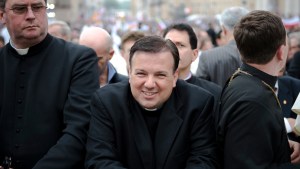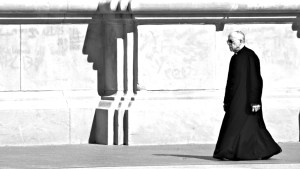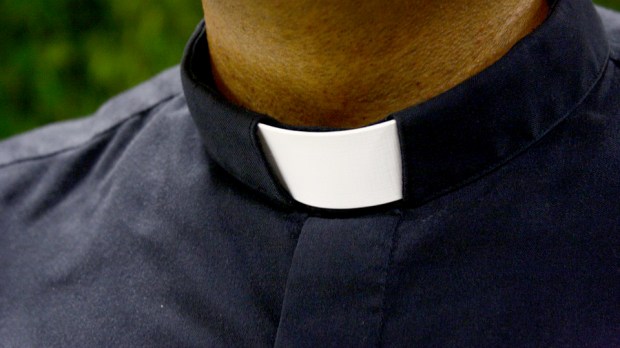The “Roman collar,” a white band that goes around the neck of a priest (or clergy members of some Protestant congregations), remains one of the most distinctive elements of clerical vesture. It speaks more loudly than any words and clearly identifies clergy members in a crowd of any size.
However, it is a rather strange piece of clothing. Where did it come from?
It wasn’t until the 12th and 13th centuries that priests adopted the Roman cassock as a distinctive piece of clothing that visually separated them from the laity. A few centuries later the cassock was regulated to be the color black and it was during this time period that the white collar came into existence.

Read more:
Why do priests wear black?
At the time the current fashion was to wear a linen collar over the top of a person’s clothing. According to Matthew Bunson, “This became accepted custom, and by the 17th century there were many forms of this linen collar, such as the ornate Roman variety, the collarino, of ornate and expensive lace, and the French adopted the collars worn by the noble classes, of linen and fine lace.”
However, Pope Urban VIII in 1624 further regulated the use of the collar and proclaimed that any ornamentation or lace was forbidden.
As the years progressed different variations of the Roman collar were developed, and Protestants developed their own traditions to distance themselves from the Church. However, it is believed that a Protestant minister in the 19th century invented the modern-day removable collar and it was further popularized by the Oxford Movement at the time.
Spiritually it has become representative of a priest’s consecration to God and his role as someone set apart for priestly service. Some priests see it as a symbol of their “slavery” to God, showing the world who is their true Master.
Additionally, because many priests find it rather uncomfortable, the collar has become a way of performing a daily penance to God, offering up the sacrifice for the people the priest serves.
The collar remains a distinctive sign of the priest’s availability and the permanent nature of Holy Orders. The priest “is not his own” and is a visible sign of Jesus Christ, present in the midst of everyday life, ready to reconcile sinners and bring souls back to God.

Read more:
A cassock: Work clothes, not a dress uniform

